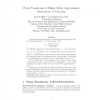Free Online Productivity Tools
i2Speak
i2Symbol
i2OCR
iTex2Img
iWeb2Print
iWeb2Shot
i2Type
iPdf2Split
iPdf2Merge
i2Bopomofo
i2Arabic
i2Style
i2Image
i2PDF
iLatex2Rtf
Sci2ools
FSS
2011
2011
Fuzzy transforms of higher order approximate derivatives: A theorem
In many practical applications, it is useful to represent a function f(x) by its fuzzy transform, i.e., by the “average” values Fi = f(x) · Ai(x) dx Ai(x) dx over different elements of a fuzzy partition A1(x), . . . , An(x) (for which Ai(x) ≥ 0 and n i=1 Ai(x) = 1). It is known that when we increase the number n of the partition elements Ai(x), the resulting approximation get closer and closer to the original function: for each value x0, the values Fi corresponding to the function Ai(x) for which Ai(x0) tend to f(x0). In some applications, if we approximate the function f(x) on each element Ai(x) not by a constant but by a polynomial (i.e., use a fuzzy transform of a higher order), we get an even better approximation to f(x). In this paper, we show that such fuzzy transforms of higher order (and even sometimes the original fuzzy transforms) not only approximate the function f(x) itself, they also approximate its derivative(s). For example, we have Fi (x0) → f (x0).
Cryptology | Erent | FSS 2011 | Fuzzy Partition | Partition Elements |
| Added | 28 Aug 2011 |
| Updated | 28 Aug 2011 |
| Type | Journal |
| Year | 2011 |
| Where | FSS |
| Authors | Irina Perfilieva, Vladik Kreinovich |
Comments (0)

